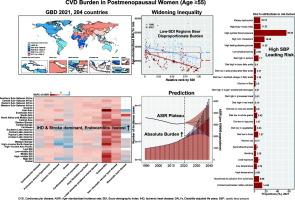1990-2040年绝经后妇女心血管疾病的全球、区域和国家负担:2021年全球疾病负担研究的系统分析
IF 13
1区 综合性期刊
Q1 MULTIDISCIPLINARY SCIENCES
引用次数: 0
摘要
背景心血管疾病(cvd)仍然是世界范围内发病率和死亡率的主要原因。在绝经后妇女中,生理变化和激素转换加速了心血管风险,但全球范围内,针对这一群体的性别特异性证据仍然有限。了解她们的负担对于解决生物脆弱性和结构性不平等问题至关重要。本综述首次对1990年至2021年 ≥ 55 岁女性心血管疾病负担进行了全面的全球、区域和国家评估,并预测了到2040年的趋势。它综合了流行病学模式、社会人口差异和主要可改变的风险因素,目的是为对性别敏感和面向公平的心血管预防和政策战略提供信息。综述的关键科学概念数据来自2021年全球疾病负担(GBD)研究,涵盖204个国家和地区。使用年龄标准化率(ASRs)分析发病率、患病率、死亡率和残疾调整生命年(DALYs)。时间趋势被量化为估计的年百分比变化(EAPCs),分解分析确定了人口(人口增长、老龄化)和流行病学的贡献。利用社会人口指数(SDI)水平的斜率和浓度指数来评估不平等。应用贝叶斯年龄-时期-队列模型预测到2040年的心血管疾病负担。主要研究结果表明,尽管ASIR和ASMR在全球范围内下降,但由于人口扩张,心血管疾病的绝对病例和死亡人数几乎翻了一番。差距扩大了:高sdi地区的降幅最大,而低sdi地区的进展较慢,甚至有恶化趋势。缺血性心脏病和中风仍然是主要的致病因素,心内膜炎是上升最快的亚型,高收缩压一直是主要的可改变的危险因素。总的来说,这些发现强调了绝经后妇女心血管疾病负担的增加和不均衡。迫切需要加强高血压控制、综合预防策略和初级卫生保健投资,特别是在低sdi环境中。本综述为支持公平的心血管健康政策和资源分配提供了一个以女性为中心的证据基础。本文章由计算机程序翻译,如有差异,请以英文原文为准。

Global, regional, and national burden of cardiovascular diseases among postmenopausal women, 1990–2040: a systematic analysis for the global burden of disease study 2021
Background
Cardiovascular diseases (CVDs) remain the leading cause of morbidity and mortality worldwide. In postmenopausal women, physiological changes and hormonal transitions accelerate cardiovascular risk, yet global, sex-specific evidence for this group remains limited. Understanding their burden is essential to address biological vulnerabilities and structural inequities.Aim of review
This review provides the first comprehensive global, regional, and national assessment of CVD burden among women aged ≥ 55 years from 1990 to 2021 and projects trends to 2040. It synthesizes epidemiological patterns, socio-demographic disparities, and major modifiable risk factors, with the goal of informing gender-sensitive and equity-oriented cardiovascular prevention and policy strategies.Key scientific concepts of review
Data were obtained from the Global Burden of Disease (GBD) Study 2021, encompassing 204 countries and territories. Incidence, prevalence, mortality, and disability-adjusted life years (DALYs) were analyzed using age-standardized rates (ASRs). Temporal trends were quantified with estimated annual percentage changes (EAPCs), and decomposition analysis identified demographic (population growth, aging) and epidemiological contributions. Inequalities were evaluated using slope and concentration indices across socio-demographic index (SDI) levels. Bayesian age–period–cohort models were applied to forecast CVD burden through 2040. Key findings indicate that although ASIR and ASMR declined globally, absolute CVD cases and deaths nearly doubled due to demographic expansion. Disparities widened: high-SDI regions achieved the steepest reductions, while low-SDI regions showed slower progress or worsening trends. Ischemic heart disease and stroke remained the dominant contributors, endocarditis was the fastest-rising subtype, and high systolic blood pressure consistently emerged as the leading modifiable risk factor. Collectively, these findings highlight a growing and uneven burden of CVD in postmenopausal women. Strengthened hypertension control, integrated prevention strategies, and investment in primary healthcare—particularly in low-SDI settings—are urgently needed. This review provides a woman-centered evidence base to support equitable cardiovascular health policy and resource allocation.求助全文
通过发布文献求助,成功后即可免费获取论文全文。
去求助
来源期刊

Journal of Advanced Research
Multidisciplinary-Multidisciplinary
CiteScore
21.60
自引率
0.90%
发文量
280
审稿时长
12 weeks
期刊介绍:
Journal of Advanced Research (J. Adv. Res.) is an applied/natural sciences, peer-reviewed journal that focuses on interdisciplinary research. The journal aims to contribute to applied research and knowledge worldwide through the publication of original and high-quality research articles in the fields of Medicine, Pharmaceutical Sciences, Dentistry, Physical Therapy, Veterinary Medicine, and Basic and Biological Sciences.
The following abstracting and indexing services cover the Journal of Advanced Research: PubMed/Medline, Essential Science Indicators, Web of Science, Scopus, PubMed Central, PubMed, Science Citation Index Expanded, Directory of Open Access Journals (DOAJ), and INSPEC.
 求助内容:
求助内容: 应助结果提醒方式:
应助结果提醒方式:


